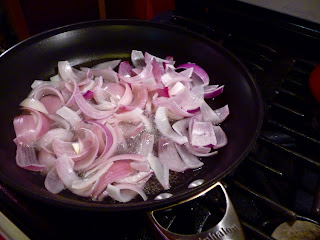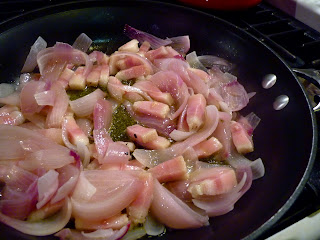The Mozza Cookbook arrived last Friday afternoon (insert giant jump for joy).
I unwrapped it, carried it upstairs, curled up on my bed and started reading passages from the introduction. Within minutes, tears had started to run down my face. I'm not kidding or exaggerating. I was moved that quickly. I'm pretty sure this is the cookbook that I've been waiting for to provide the inspiration that has been sorely lacking in my life lately. The Mozza Cookbook may be exactly what I need to get back on track.
I have, literally, been waiting for its release. Impatiently, I might add. I can tell that this book is going to stoke the cooking fires within me. The last couple of months my energy, focus, and interest have been waning. It's been such a challenge to simply make it to the market and to then get the food on the table that I've been more than a little lax about posting.
And then the guilt. A. says that with any writing project comes a bucket-load of guilt. I had no idea how right he was. I'll wake up at 4 a.m. absolutely wracked with it.
Needless to say, I have high hopes that The Mozza Cookbook will indeed jump-start my lazy-blogging-bones. It has a good chance, because if there is one woman I love, it is Nancy Silverton. She is a hero of mine. I used to be a big fan of Campanile (sadly, not so much anymore). I've eaten more than a reasonable amount of La Brea Bakery bread and goodies. I own a number of her fantastic cookbooks (Nancy Silverton's Sandwich Book, A Twist of the Wrist, The Food of Campanile), and I am obsessed to the point of distraction by her Los Angeles restaurants, Pizzeria Mozza, Osteria Mozza, Mozza2Go, and the utterly marvelous family-style meals held at the Scuola Di Pizza.
So, yes, a book replete with all the most compelling recipes from the Pizzeria and the Osteria is a thrilling tome, to be sure. You won't be disappointed with the selection. You'll find the recipe for the coveted Butterscotch Budino, the pristine Grilled Octopus with Potatoes, Celery and Lemon, the sinfully rich Fresh Ricotta and Egg Ravioli with Brown Butter, and the recipe for one of my favorite pasta dishes ever, Linguine with Clams, Pancetta, and Spicy Fresno Chiles.
Of course, I wanted to dive right in. Of course, I had hardly any time to devote to cooking, and some of the recipes are quite long. Silverton even suggests that you, "think of them as roadmaps of the Italian countryside -- detailed, long, and sometimes winding -- but they will get you where you want to go." She is very thorough in her instructions and explanations. It's as if she is by your side, in your kitchen, coaching you through the process. Very comforting.
I did dive right in. I found one of the less challenging recipes that Silverton actually recommends as a weeknight supper and managed, all the same, to fall head over heels for Silverton once again. I chose the Spaghetti Alla Gricia, because I could head down the street to Cookbook to pick up a red onion and a hunk of guanciale and I'd be all set.
Spaghetti Alla Gricia is, as Silverton explains, a white, tomatoless version of the classic Amatriciana. This essentially means that you are making a pasta dish featuring guanciale (an Italian pork, bacon-like, delicacy made of dried, unsmoked pigs' cheeks) and perhaps onions.
In Silverton's recipe the pasta is loaded with red onion petals, guanciale, Parmigiano-Reggiano, and pecorino romano. She is very firm about the necessity of guanciale. No substitutions, not even pancetta will do. Just wait until you've got the goods, before even considering this recipe, she instructs.
While her instructions are exceedingly thorough, some of her more poetic language had me scratching my head. Onion petals? Guanciale batons? Am I insane? Because when she instructs that the guanciale should be cut into 1/4-inch-thick, 2-inch-long batons, I'm wondering about the width and the thickness. My portions were about 2 inches long, and 1/4-inch wide and deep, and I think this was a little too chunky. My batons did not crisp up in 3 minutes. Not even close, so my feeling is that the batons need to be thinner. Perhaps 2-inches-long, 1/4-inch-across, and 1/8-inch thick.
Does that make any sense?
Regarding the petals, Silverton has us cutting the onion in half and then separating the layers, then cutting each layer into petals an inch wide at the middle. If I am understanding what she is ultimately seeking, I found it easier to cut the onion in half and then into 1-inch wedges, and at that point to separate the layers.
Other than my inability to fully grasp those two concepts, the recipe is a breeze and does make for a decidedly decadent weeknight meal. I was feeling rather wicked for consuming so much pork fat in one sitting. But goodness, what a deeply pleasurable way to debauch.
It's amazing that a recipe as simple as this, with as few complicated ingredients can produce such a deeply complex flavor. The ingredients include the red onion, the guanciale, extra-virgin olive oil, red pepper flakes, black pepper, whole Italian parsley leaves, Parmigiano-Reggiano, pecorino romano, and water. I was surprised and impressed by the abundant use of water. The onions are cooked in a cup of water (smart not to add more oil unnecessarily). Please note that on my stove it took twice the amount of time for the water to evaporate. Another cup of water is added to the cooked guanciale and onions to essentially create the sauce that the hot pasta will ultimately be tumbled into.
The flavor is enormous. It's porky and peppery with a hint of sweetness from the onion. The cheeses add another layer of robustness, while the parsley contributes just a bit of fresh. I really dig the generous use of whole parsley leaves. Next time I might add a handful more.
Not surprisingly, I am champing at the bit waiting to have a go at another recipe. I'm hugely intimidated, but I want to try my hand at one of her life-changing pizzas. She shows you how! What a spectacular treat it is to have Nancy at home with me.
Nancy Silverton's Spaghetti Alla Gricia
Kosher salt
1 large red onion
6 ounces guanciale, cut into 1/4-inch-thick, 2-inch-long batons
1/4 cup extra-virgin olive oil
1 teaspoon red pepper flakes
1 teaspoon fresh coarsely ground black pepper
12 ounces spaghetti
1 cup whole fresh Italian parsley leaves
2 tablespoons freshly grated Parmigiano-Reggiano
2 tablespoons freshly grated pecorino romano, plus a wedge for grating
Fill a pasta pot or a large stockpot with 6 quarts of water, add 6 tablespoons of salt, and bring the water to a boil over high heat. If you are not using a pasta pot, put a colander in the sink or have a pair of tongs handy for lifting the pasta out of the water. (See what I mean? Detailed.)
Cut the onion in half, separate the layers, and cut each layer into petals that are 1 inch wide across the middle. Put the onion petals in a large sauté pan with 1 cup of water and a big pinch of salt and cook the onion over high heat until the water evaporates, about 5 minutes. Add the guanciale and olive oil and cook over medium-high heat until the guanciale is crisp about 3 minutes. Remove the pan from the heat and add another cup of water, the red pepper flakes, and black pepper. Turn off the heat while you cook the spaghetti.
Drop the spaghetti into the boiling water, stir to prevent the strands from sticking together, partially cover the pot so the water returns to a boil quickly and continues boiling, and cook the pasta, using the time indicated on the package as a guide, until it's al dente (whew!). About 1 minute before the pasta is done, place the sauce over high heat. Lift the pasta out of the cooking water, or reserve 1 cup of the water and drain the pasta, and immediately add it to the pan with the sauce. Cook the pasta with the sauce for 2 minutes, stirring with a rubber spatula or tongs, to coat the pasta with the sauce, adding some of the reserved pasta water if the pasta is dry and sticky instead of slippery and glistening. Turn off the heat and stir in the parsley. Add the grated Parmigiano-Reggiano and pecorino romano and stir to combine.
Use the tongs to lift the spaghetti out of the pan and onto the center of each of four plates, dividing the pasta evenly, and twirling it as it falls onto the plate to form a tight mound. Spoon any sauce left in the pan over the pasta and use a microplane or another fine grater to grate a light layer of pecorino romano over each plate, and serve.
Serves 4










































